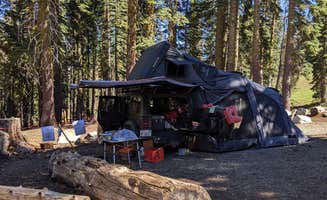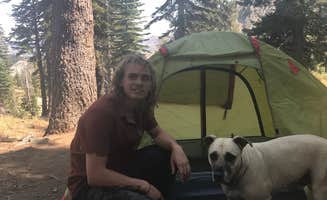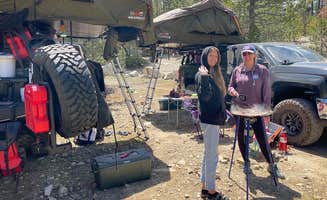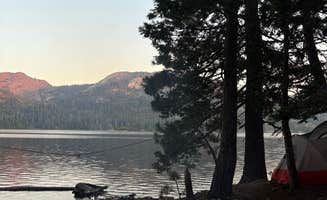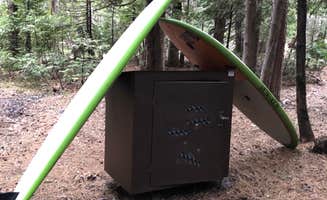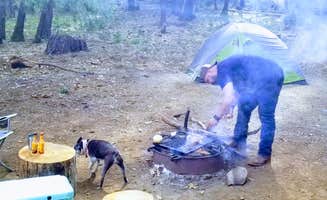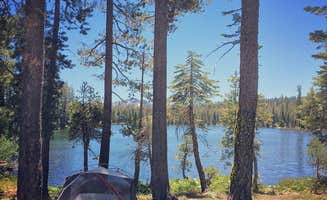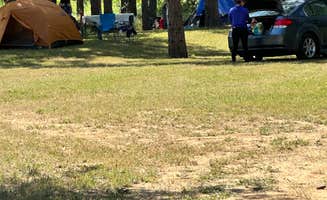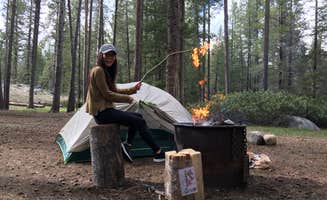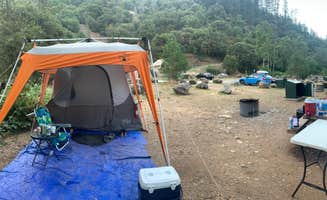Tent camping around Washington, California centers on a network of high-elevation sites within Tahoe National Forest, typically located between 5,000-7,000 feet in elevation. The region experiences significant seasonal variations with snow covering many campgrounds until late May and temperatures dropping below freezing even in summer nights at higher elevations. Most campsites require navigation of unmaintained forest service roads that worsen after spring snowmelt and summer storms.
What to do
Swimming in warm lakes: Rucker Lake offers an unusually warm swimming experience compared to other alpine lakes in the region. One camper noted, "Lake was very warm and had a epic rope swing if you can find it," while another mentioned "waterfront access and a warm lake" make it ideal for summer recreation.
Kayaking on multiple lakes: Lake Spaulding Campground provides excellent flat-water paddling opportunities. "We take our Kayaks and spend the day on the lake. It gets choppy in the afternoon so be aware," reports one regular visitor. Several interconnected lakes allow for day trips between water bodies.
Stargazing in open meadows: The open spaces around Tahoe National Forest Onion Valley Campground provide excellent night sky viewing. A camper highlighted this benefit: "I loved the open fields of wild flowers. Those open spaces allow for some great star gazing night."
Hiking to nearby waterfalls: Several trails lead to seasonal waterfalls, particularly in early summer. A visitor to Bowman Lake recommended: "Try to hike to the waterfalls at the creek at the end of the lake if you can."
What campers like
Privacy between sites: Many campgrounds feature natural spacing using terrain and vegetation. At Faucherie Lake Group Campground, one camper shared: "only once or twice did we have to share the grounds with another group!" The campground's layout utilizes existing landscape features to create separation.
Escape from summer heat: The high elevation provides relief from valley temperatures. A camper at Grouse Ridge noted: "It was 25 degrees cooler up there than in Sacramento. We loved this campground."
Boulder-framed campsites: Unique geological features create distinctive camping spaces. At Lake Spaulding, "The campgrounds are set among huge boulders and can be very private." These natural rock formations add character to sites and provide wind breaks.
Access to multiple lakes: Lindsey Lake Campground serves as a hub for exploring several nearby water bodies. A visitor explained: "Lots of lakes and hiking in the area." Many campers use one campground as a base to explore multiple lakes within a short distance.
What you should know
Road conditions require preparation: Nearly all campgrounds require navigating rough roads. A visitor to Bowman Lake Dispersed warned: "This place was a slice of heaven, but only accessible by way of 4 x 4 with decent clearance. The trail will take you off road for quite some time, but it's well with the adventure."
Carry-in water requirements: Most campgrounds lack potable water. A Canyon Creek camper advised: "Visit yearly, go kayaking at all three lakes in the area. Never crowded even on the 4th of July weekend." Campers must bring all drinking water or filter from lakes.
Walk-in campsite logistics: Several campgrounds require carrying gear from parking areas. At Rucker Lake, a camper noted: "The camp spots were a good size and with fire pits and bench tables BUT there isn't a road to actually drive around the spots, you have to park and walk all your stuff down to your spot."
Insect preparation essential: Mosquitoes are prevalent, especially in early summer. "Mosquitoes are abundant here. Don't forget your repellent," advised one Bowman Lake visitor. Bug protection should be considered essential gear.
Tips for camping with families
Lake swimming accessibility: Look for campgrounds with gentle lake entries. One family at Onion Valley reported: "Meadow near the campgrounds is amazing and was perfect for my dog to frolic through. Frogs are noisy at night due to the streams that run nearby."
Bear awareness: All campgrounds are in active bear territory. A Lake Spaulding visitor advised: "There are bears but they seem to keep to themselves but don't temp with unstored food. Tables, bear lockers, fire rings are at all campsites."
Water sports for older children: Kayaking and paddleboarding opportunities exist at multiple lakes. "Awesome spot to camp, fish, off road, launch a kayak or paddle board," reported one Bowman visitor. Several lakes allow non-motorized watercraft.
Mid-week arrivals recommended: Popular sites fill quickly on weekends. At Grouse Ridge Campground, a visitor noted: "We went mid week in August and it wasn't too crowded. The views were beautiful and the water was perfect."
Tips from RVers
Limited RV accessibility: Most campgrounds accommodate only small trailers or truck campers. A visitor to Bowman Lake cautioned: "It is possible to get a smaller trailer there but not recommended."
Boat launch parking for small RVs: Some RVers find boat launch areas provide flatter parking. "Stayed in my van on the boat launch. There are tent sites above the boat ramp with bear boxes and fire rings," shared one visitor to Bowman Lake.
Dispersed options for self-contained units: National Forest land surrounding developed campgrounds allows dispersed camping. "The surrounding area is National Forest Land, though, so you can dispersed camp for free," noted a camper familiar with the Lindsey Lake area.



